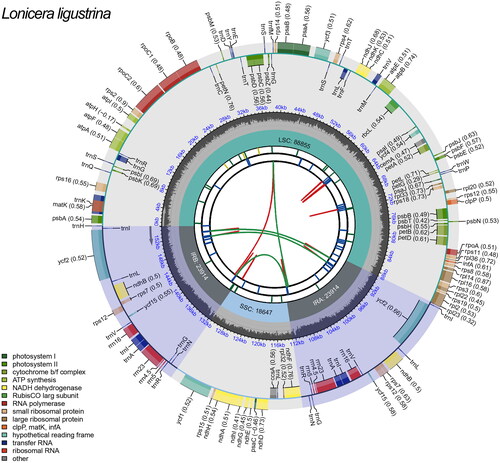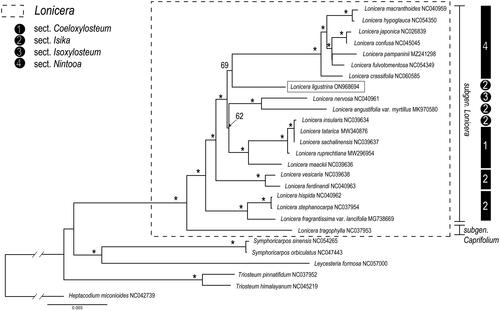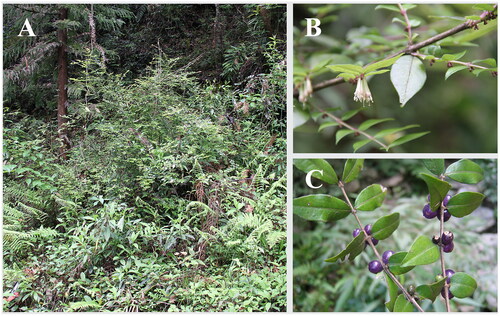Abstract
Lonicera ligustrina is a folk medicinal herb in China and India with highly potential medicinal value. Here, we reported the complete chloroplast (cp) genome of L. ligustrina (GenBank accession number: ON968694). The cp genome was 155,330 bp long, with a large single-copy region (LSC) of 88,855 bp and a small single-copy region (SSC) of 18,647 bp separated by a pair of inverted repeats (IRs) of 23,914 bp. We also reconstructed the phylogeny of Lonicera using maximum likelihood (ML) method, including our data and previously reported cp genomes of related taxa. The current study indicated that L. ligustrina is sister with the Nintooa clade of subgen. Lonicera.
1. Introduction
The genus Lonicera L., commonly known as honeysuckles, is the largest genus of Caprifoliaceae (Ren et al. Citation2008; Jacobs et al. Citation2009). Historically, it has received extensive taxonomic evaluation and phylogenetic inference, including studies based on complete chloroplast genome (Smith and Donoghue Citation2010; Fan et al. Citation2018; Wang et al. Citation2020), but so far, its phylogenetic relationships among sections, subsections, and species are still obscure (Theis et al. Citation2008; Nakaji et al. Citation2015; Wang et al. Citation2020). Lonicera ligustrina Wall.1824, is an evergreen, semi-evergreen, or deciduous shrub belonging to the section Isika of Caprifoliaceae (Hsu and Wang Citation1988). It can be classified into 3 varieties: L. ligustrina var. ligustrina, L. ligustrina var. pileata (Oliver) Franchet, L. ligustrina var. yunnanensis Franchet (Yang and Landrein Citation2011). The species varied greatly in morphology, and more research work is still needed to clarify its infraspecific classification (Zeng et al. Citation2021). At the same time, L. ligustrina, commonly used in folk herbs in China and India also has certain medicinal value (Yashodha et al. Citation2019; Murthy et al. Citation2022). Therefore, we assembled and characterized the complete chloroplast genome of L. ligustrina, which is expected to lay a solid foundation for the medical applications and future phylogenetic investigations of Lonicera.
2. Materials and methods
2.1. Plant materials and DNA extraction
Fresh leaves of L. ligustrina () were collected from Baiguoba, Enshi, Hubei province, China (30.2681 N, 109.4008E). A voucher specimen was deposited at Herbarium of Taizhou University (https://www.tzc.edu.cn/; collector: Zhong-Shuai Sun, [email protected]) under the voucher number ES548. Genomic DNA was extracted as reported in Chen et al. (Citation2022).
2.2. Plastome sequencing, assembly, and annotation
The next-generation sequencing was performed with an Illumina NovaSeq platform (Illumina, San Diego, CA). The chloroplast genome was assembled via NOVOPlasty 2.6.3 (Dierckxsens et al. Citation2017), using the L. japonica (NC026839, He et al. Citation2017) as the initial reference genome. The assembled cp genome was annotated using the online software GeSeq v.1.59 (Tillich et al. Citation2017). Geneious R11 (Biomatters Ltd., Auckland, New Zealand) was used for inspecting the cp genome structure. The circular gene map of the chloroplast genome was drawn by d by CPGView software (Liu et al. Citation2023, http://www.1kmpg.cn/cpgview/).
2.3. Phylogenetic analysis
Species phylogeny of Lonicera was evaluated based on protein coding regions (CDS) extracted from 27 complete chloroplast genomes from Caprifoliaceae. Heptacodium miconioides (NC042739, Wang et al. Citation2019) was used as outgroup. We reconstructed a phylogeny employing the GTR + G model and 1000 bootstrap replicates under the maximum likelihood (ML) inference in RAxML-HPC v.8.2.10 on the CIPRES cluster (Miller et al. Citation2010).
3. Results
3.1. Genome organization and compositions
The complete chloroplast genome of L. ligustrina is 155,330 bp in length. It has a typical quadripartite structure with a large single-copy (LSC) region of 88,855 bp, a small single-copy (SSC) region of 18,647 bp, and a pair of inverted repeats (IRs) of 23,914 bp (). The GC contents of the total length, LSC, SSC, and IR regions were 38.5%, 36.9%, 33.4% and 43.3%, respectively.
Figure 2. Schematic map of L. ligustrina chloroplast genome constructed by CPGview (http://www.1kmpg.cn/cpgview/). The functional classification is shown at the bottom left.

The genome contains a total of 129 functional genes, including 84 protein-coding genes (PCGs), 37 tRNA genes and 8 rRNA genes. Most genes occurred in a single copy, while 5 PCGs (ycf2, ndhB, rps7, rps12 and ycf15), 7 tRNA genes (trnI-CAU, trnL-CAA, trnV-GAC, trnI-GAU, trnA-UGC, trnR-ACG and trnN-GUU), and 4 rRNA genes (rrn4.5, rrn5, rrn16, rrn23) in IR regions are duplicated. Of all these genes, 15 genes (rps16, atpF, rpoC1, petB, petD, rpl16, rpl2, ndhB, ndhA, trnK-UUU, trnG-UCC, trnL-UAA, trnV-UAC, trnI-GAU, and trnA-UGC) had one intron and 3 genes (rps12, rps18 and ycf3) had two introns.
3.2. Phylogenetic analysis
A robust phylogeny of Lonicera was obtained based on the CDS data, most nodes in the ML tree were highly supported, and the genus was resolved as a monophyletic clade consisting two well supported clades which consistent with the previous research which divided Lonicera into two subgenera: subgen. Caprifolium and subgen. Lonicera (). The subgen. Lonicera clade consisted of species from 4 sections (sect. Coeloxylosteum, sect. Isika, sect. Isocylosteum, sect. Nintooa), but in our phylogenetic tree, only the species from sect. Nintooa were clustered into a monophyletic clade. According to the phylogenetic tree, the sister relationship between L. ligustrina and L. ligustrina clade was observed.
Figure 3. Maximum likelihood (ML) tree reconstruction of 27 taxa from Caprifoliaceae based on 84 shared CDS in the chloroplast genomes. Relative branch lengths are indicated. Support values above the branches are ML bootstrap support; ‘*’ indicates 100% support values. The following sequences were used: NC042739 (Wang et al. Citation2019), NC045219 (Liu et al. Citation2019), NC057000 (Zhang Citation2020), NC047443 (Shen et al. Citation2019), NC054265 (Zhang et al. Citation2020), NC037952 (Fan et al. Citation2018), NC037953 (Fan et al. Citation2018), MG738669 (Fan et al. Citation2018), NC037954 (Fan et al. Citation2018), NC040961 (Liu et al. Citation2018), NC040962 (Liu et al. Citation2018), NC040963 (Liu et al. Citation2018), NC039636 (Jia et al. Citation2020), NC039637 (Jia et al. Citation2020), NC039638 (Jia et al. Citation2020), NC039634 (Jia et al. Citation2020), MW296954 (Gu et al. Citation2022), MW340876 (Yuan et al. Citation2021), MK970580 (Wu et al. Citation2021), NC060585 (Chen et al. Citation2022), NC054349 (Yu et al. Citation2021), NC054350 (Gu et al. Citation2021), MZ241298 (Jiang et al. Citation2021), NC045045 (Wang et al. Citation2019), NC026839 (He et al. Citation2017); NC040959 (Hu et al. Citation2018).

4. Discussion
The current study presented the complete chloroplast genome of L. ligustrina and a highly resolved phylogenies of Lonicera based on 27 complete chloroplast genome from Caprifoliaceae. Our result supports the classification of the two subgenera, subgen. Lonicera and subgen. Caprifolium, in Lonicera proposed by Rehder (Citation1903, Citation1913) and Hsu and Wang (Citation1988) and coincides with previous molecular phylogenetic studies (Theis et al. Citation2008; Nakaji et al. Citation2015; Wu et al. Citation2021). Among the four sections of subgen. Lonicera, sect. Nintooa was supported as monophyly, and L. ligustrina is sister with the Nintooa clade with strong bootstrap support (). We expect that the cp genome of L. ligustrina will be a valuable resource for future studies on molecular identification and the better understanding of phylogeny in Lonicera and Caprifoliaceae.
Ethical approval
The material involved in the article does not involve ethical conflicts. This study was permitted by College of Chemistry and Materials Engineering, Quzhou University, China. All collection and sequencing work was strictly executed under local legislation and related laboratory regulations to protect wild resources.
Authors’ contributions
The article was designed and conceived by Jian-Hui Li; Li-Li Liu and Zhong-Shuai Sun assembled and annotated the cp genome; Zhong-Shuai Sun collected and identified the plant material; Li-Li Liu contributed significantly to phylogenetic analysis and manuscript preparation; Jian-Hui Li was involved in interpretation of the data and revised the manuscript critically for intellectual content. All authors approved the final version to be published and agreed to be accountable for all aspects of the work.
Supplemental Material
Download TIFF Image (3.8 MB)Supplemental Material
Download TIFF Image (13.4 MB)Supplemental Material
Download TIFF Image (2.8 MB)Disclosure statement
The authors report no conflicts of interest and are responsible for the content and writing of the paper.
Data availability statement
The genome sequence data that support the findings of this study are openly available in GenBank of NCBI at (https://www.ncbi.nlm.nih.gov/) under the accession no. ON968694. The associated BioProject, SRA, and Bio-Sample numbers are PRJNA894792, SRR22061799 and SAMN31469260 respectively.
Additional information
Funding
References
- Chen C, Qu DH, Shan FQ, Jin ZX, Sun ZS. 2022. Complete chloroplast genome of Lonicera crassifolia Batalin (Caprifoliaceae) and its phylogenetic implications. Mitochondrial DNA B Resour. 7(5):732–734. doi: 10.1080/23802359.2022.2068979.
- Dierckxsens N, Mardulyn P, Smits G. 2017. NOVOPlasty: de novo assembly of organelle genomes from whole genome data. Nucleic Acids Res. 45(4):e18. doi: 10.1093/nar/gkw955.
- Fan WB, Wu Y, Yang J, Shahzad K, Li ZH. 2018. Comparative chloroplast genomics of Dipsacales species: insights into sequence variation, adaptive evolution, and phylogenetic relationships. Front Plant Sci. 9:689. doi: 10.3389/fpls.2018.00689.
- Gu L, Hou Y, Wang G, Liu Q, Ding W, Weng Q. 2022. Characterization of the chloroplast genome of Lonicera ruprechtiana Regel and comparison with other selected species of Caprifoliaceae. PLoS One. 17(1):e0262813. doi: 10.1371/journal.pone.0262813.
- Gu L, Wu Q, Yi Y, Yu Z. 2021. The complete chloroplast genome of Lonicera hypoglauca Miq (Caprifoliaceae: dipsacales) from Guangxi, China. Mitochondrial DNA B Resour. 6(2):450–451. doi: 10.1080/23802359.2020.1870903.
- He L, Qian J, Li X, Sun Z, Xu X, Chen S. 2017. Complete chloroplast genome of medicinal plant Lonicera japonica: genome rearrangement, intron gain and loss, and implications for phylogenetic studies. Molecules. 22(2):249. doi: 10.3390/molecules22020249.
- Hsu PS, Wang HJ. 1988. Lonicera. In: Hsu PS, editor. Flora reipublicae popularis sinicae. Vol. 72. Beijing: Science Press; p. 143–259.
- Hu H, Liu J, An J, Wang M, Wang Q. 2018. Characterization of the complete chloroplast genome of Lonicera macranthoides. Mitochondrial DNA B Resour. 3(2):1000–1001. doi: 10.1080/23802359.2018.1507643.
- Jacobs B, Lens F, Smets E. 2009. Evolution of fruit and seed characters in the Diervilla and Lonicera clades (Caprifoliaceae, Dipsacales). Ann Bot. 104(2):253–276. doi: 10.1093/aob/mcp131.
- Jia G, Wang H, Yu P, Li P. 2020. The complete chloroplast genome of the Lonicera maackii (Caprifoliaceae), an ornamental plant. Mitochondrial DNA B Resour. 5(1):560–561. doi: 10.1080/23802359.2019.1710288.
- Jiang C, Wu S, Feng X, Yang C, Yu Z. 2021. The complete chloroplast genome of Lonicera pampaninii Levl. and its phylogenetic analysis. Mitochondrial DNA B Resour. 6(10):3025–3027. doi: 10.1080/23802359.2021.1978891.
- Liu HR, Fang J, Xia M, Xiao Q, Zhang D, Xie J, Chen S. 2019. The complete chloroplast genome of Triosteum himalayanum (Caprifoliaceae), a perennial alpine herb. Mitochondrial DNA B Resour. 4(2):4194–4195. doi: 10.1080/23802359.2019.1693289.
- Liu ML, Fan WB, Wang N, Dong PB, Zhang TT, Yue M, Li ZH. 2018. Evolutionary analysis of plastid genomes of seven Lonicera L. species: implications for sequence divergence and phylogenetic relationships. Int J Mol Sci. 19(12):4039. doi: 10.3390/ijms19124039.
- Liu S, Ni Y, Li J, Zhang X, Yang H, Chen H, Liu C. 2023. CPGView: a package for visualizing detailed chloroplast genome structures. Mol Ecol Resour. 23:1–11.
- Miller MA, Pfeiffer W, Schwartz T. 2010. Creating the CIPRES Science Gateway for inference of large phylogenetic trees. Gatew Comput Environ Workshop. 14:1–8.
- Murthy C, Sanapala AK, Sambamoorthy U, Kasireddy P, Namratha S. 2022. Phytochemical screening and Invitro Anticancer activity of Lonicera ligustrina leaf extract on Breast and Colorectal carcinoma cell lines. RJPT. 3485–3489. doi: 10.52711/0974-360X.2022.00584.
- Nakaji M, Tanaka N, Sugawara T. 2015. A molecular phylogenetic study of Lonicera L. (Caprifoliaceae) in Japan based on chloroplast DNA sequences. Acta Phytotaxon Geobot. 66(3):137–151.
- Rehder A. 1903. Synopsis of the genus Lonicera. Missouri Bot Gard Ann Rep. 1903:27. doi: 10.2307/2400049.
- Rehder A. 1913. Caprifoliaceae. In: Sargent CS, editor. Plantae wilsonianae: an enumeration of the woody plants collected in western China for the arnold arboretum of harvard university during the years 1907, 1908, and 1910. Cambridge: Harvard University Press; p. 106–144.
- Ren MT, Chen J, Song Y, Sheng LS, Li P, Qi LW. 2008. Identification and quantification of 32 bioactive compounds in Lonicera species by high performance liquid chromatography coupled with time-of-flight mass spectrometry. J Pharm Biomed Anal. 48(5):1351–1360. doi: 10.1016/j.jpba.2008.09.037.
- Shen XL, Zhu YX, Wu YM, Tong L, Mu XY. 2019. The complete chloroplast genome of Symphoricarpos orbiculatus (Caprifoliaceae), an important ornamental plant. Mitochondrial DNA B Resour. 4(2):3173–3174. doi: 10.1080/23802359.2019.1668310.
- Smith SA, Donoghue MJ. 2010. Combining historical biogeography with niche modeling in the Caprifolium clade of Lonicera (Caprifoliaceae, Dipsacales). Syst Biol. 59(3):322–341. doi: 10.1093/sysbio/syq011.
- Theis N, Donoghue MJ, Li JH. 2008. Phylogenetics of the Caprifolieae and Lonicera (Dipsacales) based on nuclear and chloroplast DNA sequences. Syst Bot. 33(4):776–783. doi: 10.1600/036364408786500163.
- Tillich M, Lehwark P, Pellizzer T, Ulbricht-Jones ES, Fischer A, Bock R, Greiner S. 2017. GeSeq-versatile and accurate annotation of organelle genomes. Nucleic Acids Res. 45(W1):W6–W11. doi: 10.1093/nar/gkx391.
- Wang HX, Liu H, Moore MJ, Landrein S, Liu B, Zhu ZX, Wang HF. 2020. Plastid phylogenomic insights into the evolution of the Caprifoliaceae s.l. (Dipsacales). Mol Phylogenet Evol. 142:106641. doi: 10.1016/j.ympev.2019.106641.
- Wang HX, Tan XH, Wang JH, Zhao KK, Zhu ZX, Wang HF. 2019. Complete plastome sequence of Heptacodium miconioides Rehd. (Caprifoliaceae): an Endangered (EN) plant species endemic to China. Mitochondrial DNA Part B Resour. 4(1):64–65. doi: 10.1080/23802359.2018.1536457.
- Wu YM, Ma D, Zhu YX, Liu B, Mu XY. 2021. Characterization of the complete chloroplast genome of a subalpine deciduous shrub Lonicera angustifolia var. myrtillus (Caprifoliaceae). Mitochondrial DNA B Resour. 6(7):1796–1798. doi: 10.1080/23802359.2021.1931507.
- Yang QE, Landrein S. 2011. Lonicera linnaeus. In: Raven PH, Wu ZY, Hong DY, editors. Flora of China. Vol. 19. Beijing: Science Press; p. 620–641.
- Yashodha A, Parveen H, Begum S, Santhoshi G, Bharath M, Ashok A. 2019. A study on phytochemical & anti-nociceptive activity of Lonicera ligustrina leaf extract. Int J of Allied Med Sci and Clin Res. 7(3):679–687.
- Yu Z, Yi Y, Gu L. 2021. The complete chloroplast genome of Lonicera fulvotomentosa Hsu et S. C. Cheng and its phylogenetic analysis. Mitochondrial DNA B Resour. 6(3):842–843. doi: 10.1080/23802359.2021.1884027.
- Yuan W, Ma Y, He S, Chang D, He Y. 2021. Characterization of the complete chloroplast genome of Lonicera tatarica L. (Caprifoliaceae). Mitochondrial DNA B Resour. 6(7):1871–1872. doi: 10.1080/23802359.2021.1934140.
- Zeng YP, Luo YF, Yang QE. 2021. Reinstatement of Lonicera tricalysioides (Caprifoliaceae) as a distinctive species from china. Phytotaxa. 490(2):183–190. doi: 10.11646/phytotaxa.490.2.4.
- Zhang H. 2020. Characterization of the complete chloroplast genome of Leycesteria formosa wall. (Caprifoliaceae), a medicinal plant in southwest China. Mitochondrial DNA B Resour. 5(1):500–501. doi: 10.1080/23802359.2019.1704652.
- Zhang Y, Zhang QY, Ran H, Cao Y. 2020. Characteristic of the complete chloroplast genome of Symphoricarpos sinensis, an important ornamental plant endemic to China. Mitochondrial DNA B Resour. 5(3):3170–3171. doi: 10.1080/23802359.2020.1807423.

